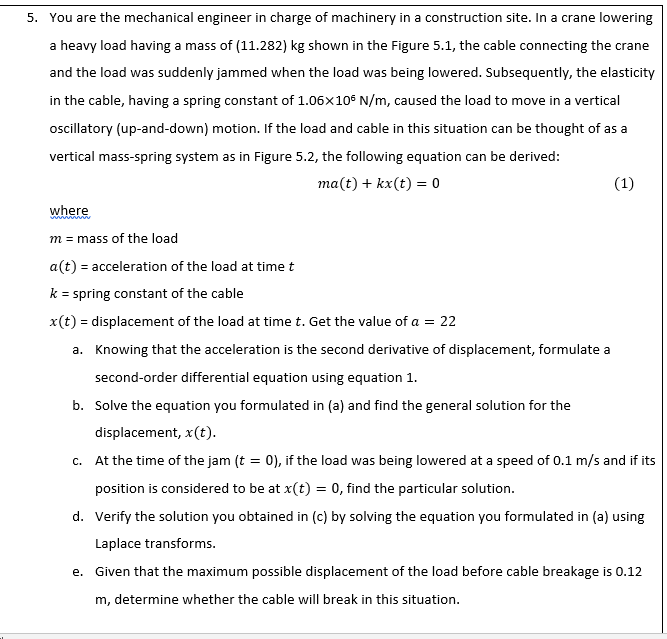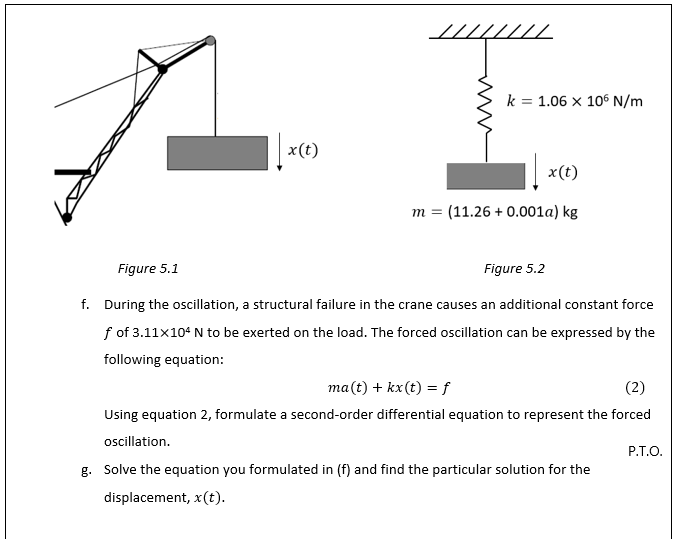5. You are the mechanical engineer in charge of machinery in a construction site. In a crane lowering a heavy load having a mass of (11.282) kg shown in the Figure 5.1, the cable connecting the crane and the load was suddenly jammed when the load was being lowered. Subsequently, the elasticity in the cable, having a spring constant of 1.06x10° N/m, caused the load to move in a vertical oscillatory (up-and-down) motion. If the load and cable in this situation can be thought of as a vertical mass-spring system as in Figure 5.2, the following equation can be derived: ma(t) + kx(t) = 0 (1) where wwwwwww m = mass of the load a(t) = acceleration of the load at time t k = spring constant of the cable x(t) = displacement of the load at time t. Get the value of a = 22 a. Knowing that the acceleration is the second derivative of displacement, formulate a second-order differential equation using equation 1. b. Solve the equation you formulated in (a) and find the general solution for the displacement, x(t). c. At the time of the jam (t = 0), if the load was being lowered at a speed of 0.1 m/s and if it position is considered to be at x(t) = 0, find the particular solution. d. Verify the solution you obtained in (c) by solving the equation you formulated in (a) using Laplace transforms. e. Given that the maximum possible displacement of the load before cable breakage is 0.12 m, determine whether the cable will break in this situation.
5. You are the mechanical engineer in charge of machinery in a construction site. In a crane lowering a heavy load having a mass of (11.282) kg shown in the Figure 5.1, the cable connecting the crane and the load was suddenly jammed when the load was being lowered. Subsequently, the elasticity in the cable, having a spring constant of 1.06x10° N/m, caused the load to move in a vertical oscillatory (up-and-down) motion. If the load and cable in this situation can be thought of as a vertical mass-spring system as in Figure 5.2, the following equation can be derived: ma(t) + kx(t) = 0 (1) where wwwwwww m = mass of the load a(t) = acceleration of the load at time t k = spring constant of the cable x(t) = displacement of the load at time t. Get the value of a = 22 a. Knowing that the acceleration is the second derivative of displacement, formulate a second-order differential equation using equation 1. b. Solve the equation you formulated in (a) and find the general solution for the displacement, x(t). c. At the time of the jam (t = 0), if the load was being lowered at a speed of 0.1 m/s and if it position is considered to be at x(t) = 0, find the particular solution. d. Verify the solution you obtained in (c) by solving the equation you formulated in (a) using Laplace transforms. e. Given that the maximum possible displacement of the load before cable breakage is 0.12 m, determine whether the cable will break in this situation.
Elements Of Electromagnetics
7th Edition
ISBN:9780190698614
Author:Sadiku, Matthew N. O.
Publisher:Sadiku, Matthew N. O.
ChapterMA: Math Assessment
Section: Chapter Questions
Problem 1.1MA
Related questions
Question
only need part d and part e

Transcribed Image Text:5. You are the mechanical engineer in charge of machinery in a construction site. In a crane lowering
a heavy load having a mass of (11.282) kg shown in the Figure 5.1, the cable connecting the crane
and the load was suddenly jammed when the load was being lowered. Subsequently, the elasticity
in the cable, having a spring constant of 1.06x10° N/m, caused the load to move in a vertical
oscillatory (up-and-down) motion. If the load and cable in this situation can be thought of as a
vertical mass-spring system as in Figure 5.2, the following equation can be derived:
ma(t) + kx(t) = o
(1)
where
m = mass of the load
a(t) = acceleration of the load at time t
k = spring constant of the cable
x(t) = displacement of the load at time t. Get the value of a = 22
a. Knowing that the acceleration is the second derivative of displacement, formulate a
second-order differential equation using equation 1.
b. Solve the equation you formulated in (a) and find the general solution for the
displacement, x(t).
c. At the time of the jam (t = 0), if the load was being lowered at a speed of 0.1 m/s and if its
position is considered to be at x(t) = 0, find the particular solution.
d. Verify the solution you obtained in (c) by solving the equation you formulated in (a) using
Laplace transforms.
е.
Given that the maximum possible displacement of the load before cable breakage is 0.12
m, determine whether the cable will break in this situation.

Transcribed Image Text:k = 1.06 x 106 N/m
|x(t)
x(t)
m = (11.26 + 0.001a) kg
Figure 5.1
Figure 5.2
f. During the oscillation, a structural failure in the crane causes an additional constant force
f of 3.11x104 N to be exerted on the load. The forced oscillation can be expressed by the
following equation:
ma(t) + kx(t) = f
(2)
Using equation 2, formulate a second-order differential equation to represent the forced
oscillation.
P.T.O.
g. Solve the equation you formulated in (f) and find the particular solution for the
displacement, x(t).
Expert Solution
This question has been solved!
Explore an expertly crafted, step-by-step solution for a thorough understanding of key concepts.
Step by step
Solved in 3 steps with 1 images

Knowledge Booster
Learn more about
Need a deep-dive on the concept behind this application? Look no further. Learn more about this topic, mechanical-engineering and related others by exploring similar questions and additional content below.Recommended textbooks for you

Elements Of Electromagnetics
Mechanical Engineering
ISBN:
9780190698614
Author:
Sadiku, Matthew N. O.
Publisher:
Oxford University Press

Mechanics of Materials (10th Edition)
Mechanical Engineering
ISBN:
9780134319650
Author:
Russell C. Hibbeler
Publisher:
PEARSON

Thermodynamics: An Engineering Approach
Mechanical Engineering
ISBN:
9781259822674
Author:
Yunus A. Cengel Dr., Michael A. Boles
Publisher:
McGraw-Hill Education

Elements Of Electromagnetics
Mechanical Engineering
ISBN:
9780190698614
Author:
Sadiku, Matthew N. O.
Publisher:
Oxford University Press

Mechanics of Materials (10th Edition)
Mechanical Engineering
ISBN:
9780134319650
Author:
Russell C. Hibbeler
Publisher:
PEARSON

Thermodynamics: An Engineering Approach
Mechanical Engineering
ISBN:
9781259822674
Author:
Yunus A. Cengel Dr., Michael A. Boles
Publisher:
McGraw-Hill Education

Control Systems Engineering
Mechanical Engineering
ISBN:
9781118170519
Author:
Norman S. Nise
Publisher:
WILEY

Mechanics of Materials (MindTap Course List)
Mechanical Engineering
ISBN:
9781337093347
Author:
Barry J. Goodno, James M. Gere
Publisher:
Cengage Learning

Engineering Mechanics: Statics
Mechanical Engineering
ISBN:
9781118807330
Author:
James L. Meriam, L. G. Kraige, J. N. Bolton
Publisher:
WILEY